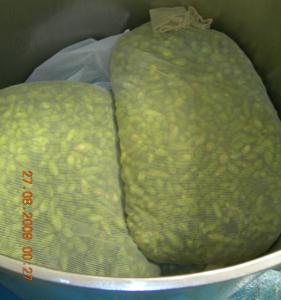 One of the more common questions I get when teaching classes about beer or when hosting beer dinners is: “What is “dry hopping?”
One of the more common questions I get when teaching classes about beer or when hosting beer dinners is: “What is “dry hopping?”
In the standard brewing process, hops are added to the wort during the boil. This explodes the oils from the hops into the beer where they add bitterness, flavor, and aroma. Unfortunately, you lose some of the most volatile flavors and aromas in this process. If you want to preserve these volatile characteristics and add an extra bit of hop character, you can use a process called “dry hopping.”
Dry hopping involves adding hops into the beer AFTER it’s cooled down. This method is technically called “cold infusion.” It’s probably been used for as long as hops have been used in beer making. Historically, though, it came into prominence in England with the cask drawn systems. Besides adding flavor, the hops also function as a clarifying agent allowing heavier sediments to settle to the bottom of the cask quicker than they otherwise would. This allowed the live cask beer (it’s still fermenting in the cask) to be more visually appealing. The hops would be added directly to the vessel. Sometimes they’d be placed in a small bag and would operate similar to a “teabag.”

“Tea bags” of hops in a hop back (picture from bierfactory.ch).
This had the added benefit of adding the delicate hop aromas and flavors to the beer without increasing real bitterness. This is still how many “firkin” or cask ales are served, with a small bag of hops in the cask. On a larger scale, a brewery has a variety of methods they can use to “dry hop” a beer. They can drop a large bag of hops into the fermenting vessel and allow it to slowly impart its hoppy goodness while the beer ferments. Or, they can add them in while the beer is conditioning (after fermentation).
Some breweries are investing a lot of time and money to create new and more efficient ways to dry hop their beers. To be honest, the “tea bag” method is pretty inefficient and with the ever-increasing demand for hops, not wasting valuable resources is even more important than ever. When you open the bag, the hops in the center are dry and haven’t imparted any of their flavor into their beer. They’re basically wasted. Sierra Nevada Brewing created a hop “torpedo” that they use to filter the beer through as it sits in the fermenter. The beer is circulated out of the fermenter, into the torpedo, then back into the fermenter. Using time, temperature, and speed, they can control what kind of characteristics the beers pick up from the hops. Their Torpedo Extra IPA beer uses this process and is named after it. The link talks about the beer and how the torpedo works.
Dry hopping is a very popular technique, especially since the rise in popularity of hop driven beers such as IPAs. Although you see dry hopping most frequently in IPAs and other hop driven beers, the technique can work with many different styles. One of my favorite dry hopped beers is Stone Brewing’s Levitation Ale. It’s a 4.5% ABV amber ale. The dry hopping takes a lighter, maltier beer and adds a lovely twist. The hop character added by dry hopping is delicate and doesn’t overpower the nice malt character.
Dry hopping is an old technique, but one that is spurring ingenuity and innovation in breweries. It’s the ideal way to get the beauty out of hops without tipping the bitterness scale. Whether it be in a tea bag or a torpedo, or some yet to be invented method, dry hopping is here to stay.
(Do you have a question about beer? Ask me on the Q & Ale page! Or just read some of the other questions).

